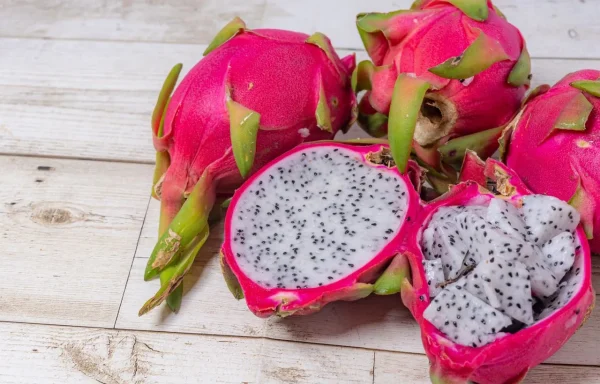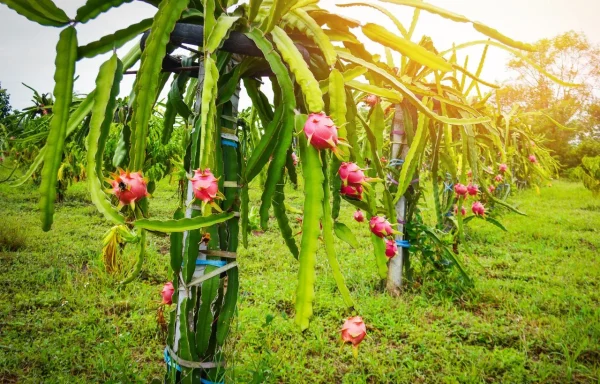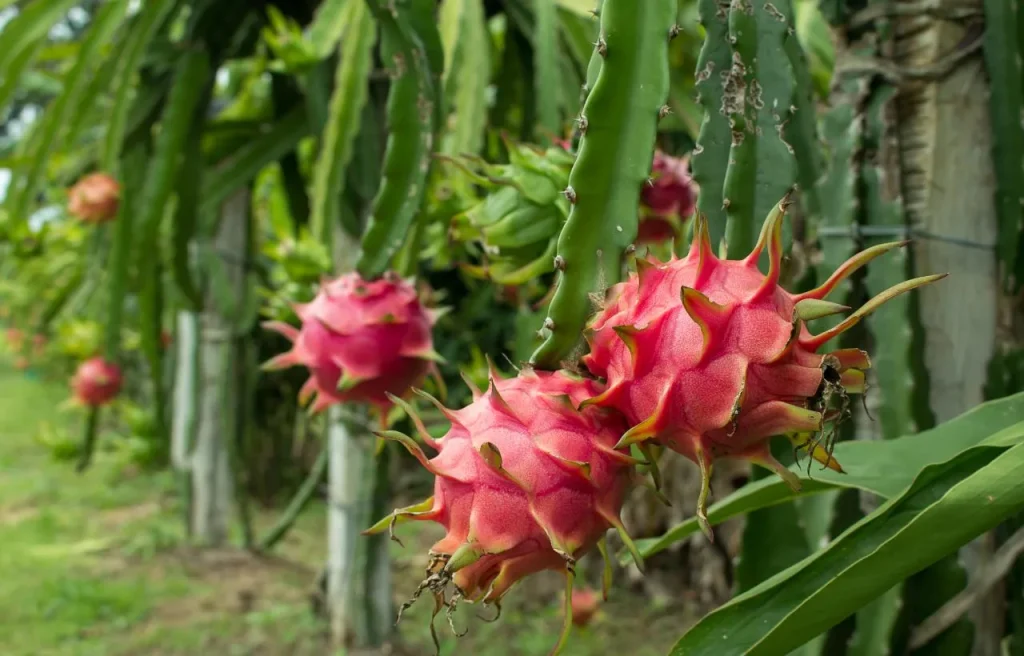Over the last two decades, dragon fruit has stolen the show. A cactus-like tree that holds large, nutrient-dense dark pink fruits is the best description for a dragon fruit tree. You can just cut the fruit and enjoy a scoop of fresh dragon fruit flesh. Sweet and easy taste. I think you might feel interested to grow this fruit on your own. But what if I don’t a vast space to grow your dragon? Can I grow dragon fruit plant indoors? Yes!
With this happy feeling, shall we uncover the techniques to grow dragon fruit plant indoors? This fruit-growing read from Gardening’s Core will bullet the nutrient value, propagation hacks, and growing necessaries for your dragon fruit plant indoors. Let’s begin the dragon fruit haul.
Dragon Fruit: A good fruit
We all know that edible plants have some nutrient value that keeps them in the good book. So, dragon fruit is also not different.
If we think of the inside part of dragon fruit is juicy and grey and mostly has a property named lycopene. This nutrient is very good for your health, it will keep your heart well-functioning and less cancer occurrence which means the dragon nutrients help your body fight carcinogenic substances. It’s a crazy good thing.
However, dragon fruits are a good source of phosphorus, calcium and vitamin C. So, keeping this good fruit in the dietary list is a wise thing.
Dragon Fruit: Origin and history
This cactus fruit (Hylocereus undatus) originated in South and Central America. Within a few years, it became popular all over the world and most countries are trying to harvest this sweet fruit. Central and southern America calls it as Pitaya raja. We can state that Vietnam as the top cultivator of dragon fruits and it is now a booming fruit in Southeast Asian markets.
Dragon fruit has quite an interesting story. It is said that it came from the dragon’s mouth and these sweetest thing has great value. Moreover, the fruit comes out from the dragon’s mouth flame. So, these are myths about sweet dragon fruit.
What are the varieties of dragon fruit?

This tropical fruit has numerous varieties of different knobby skin, color and inside taste. From the beginning, the fruit has not many varieties but slowly other varieties came to light. Besides Hylocereus, Selenicereus megalanthus is another species of dragon fruit. Let’s see the varieties one by one-
- Vietnam Jaina: It is a very popular dragon fruit variety and top export quality fruit. This variety is top-notch. Because these are easy to grow, commercially desirable and have fabulous taste. The Vietnamese Jaina can be big about 1-2 pounds.
- Yellow dragon: Yellow-colored skin and white flesh inside. It is a fruit of the Hylocereus megalanthus cactus plant. Mostly from October-December, this fruit is abundant in the USA commercially.
- Purple haze: It is another variety with a texture like Kiwi fruits. This variety is a big one and can weigh up to 2 pounds.
- Voodoo Child: According to its name, this variety is small and punches a sweet flavor. The fruits are so small that mostly size up to 0.5- 0.7 pounds.
- Makisupa: Another variety with an oblong shape and fleshy fruit inside. But the flesh of this fruit is pink colored and the skin is lighter than regular dragon fruits.
Can I grow dragon fruit plant indoors with these varieties? Of course. There are many other varieties of dragon fruit like Costa Rican sunset, David Bowie, Red Jaina, Natural mystic, Harpua and etc.
What do I need to grow a Dragon fruit plant indoors?
Now that you learned about the dragon fruit health benefits, varieties, and growing zones. Let’s see what you need to grow them inside. Though the USDA growing zone 9-11 are best to grow the different varieties of this cacti fruit but still, other zones like cooler zones can try growing the dragon fruit in pots. Can I grow dragon fruit plant indoors? Let’s see how:

- Soil: It is very wise to use the well-drained potting mix for dragon fruit plant indoors. Though the dragon fruits grow like cactus but the soil requirement differs from the cacti. Peat moss, perlite, fresh compost is must for your potting mix. Organic compost. In terms of soil pH, you should use neutral soil from pH 6-7. Nutrient-rich soil is always best for the indoor potting mix. 30% peat moss, 30% organic compost and 40% regular soil mixture. Sands, and pebbles are also used in the potting mix to increase water drainage.
- Sunlight: To grow the dragon fruits sunny location is a must. If you are planning to grow these fleshy fruit plants as a house plant then keep the plants to the south where they can get at least 6-8 hours of sunlight daily. Frequently rotate the plant so that every side of the plant gets enough sunlight. You can use the grow light to support your dragon fruit trees. Without the proper sunlight, your plant will not develop and fruiting may be late
- Watering: Pouring water over your indoor dragon fruit is not a necessary thing. As they are cactus fruit plants so less water is okay for them. The Vietnamese Jaina variety is even considered as drought-resistant. So, the dragon fruit plant doesn’t love wet soil.
- Temperature: Yes, dragon fruit plant love the sun vibe but it can’t take temperatures above 35-40° Temperature from 20-30°C works best for them. Avoid the hot places in your house which have more temperatures and keep the plants in a safe, warm room.
- Air and humidity: Less air in the room or excess stems and bushes in the dragon fruit plant can cause fungal diseases. So, prune the dragon cactus for more air passes and good growth. Again humidity should not be above 50%. Less humidity or excess humid places can hold the plant growth in winter and fall.
- Container/ pot size: When you planning to grow seedlings or plants of dragon fruits inside indoors, then you must know what types of containers you should pick. There are growing bags, earthen pots, and plastic pots. A large pot with a wide mouth like 12-24 inches and a depth of 20-25 inches are right to pick to grow your indoor dragon plant
The best options for growing dragon fruits at a glance…
| Sunlight | 6-8 hours |
| Temperature | 20-30 degree C |
| Soil type | Well-drained, nutrient-rich soil |
| Humidity | 40-50% |
| Water | Moderate watering |
How to start the dragon fruit plant indoor mission?
Well, the dragon fruit seeds and cuttings all are available to kick off the plan. Unlike many other fruit/ veggie plants and cacti, dragon fruits are also easy to propagate.
Seeds: Use fresh seeds from the garden center/ from your fruits and rinse the seeds with water then place them in an indoor potting mix and wait till the seeds sprout. After the roots come out, you can place them in the garden or repot the roots in a separate potting mixture. Summer is the growing season of sowing dragon fruit seeds.
Cutting: If you have cuttings of dragon fruit plant, you can easily rely on these as indoor plants. The cuttings should be healthy and tender. Gently cut the ends of those segments and place those in the indoor dragon potting mix. Place them 2-3 inches deep inside the potting mix. Your cuttings can be long or even. Don’t overwater the cuttings. You can propagate the cuttings by water or directly in the soil.
The dragon fruits are self-pollinating and the flowers of the plants come and disappear quickly but when the flower starts to die off, the fruiting countdown begins. And in the late summer you can actually enjoy the fire-dragon fruits.
Best tips: For a healthy dragon fruit Plant indoors
Well, we have taken the notes that make an indoor dragon fruit plant easier. But there are some Dos and Don’ts for a happy plant:
- For example, the dragon fruit plant needs regular pruning, otherwise, the plant grows vigorously and becomes bushy. Some varieties can be 400-500 cm long. So, cut the side stems except for the main one and let it grow. You can even report the cut stems for more sweet, fleshy fruits
- Moderate fertilizing. You can’t add lots of chicken manure to your potting mix because they’re not a high demand for nitrogen fertilizer in this fruit cactus.
- Don’t use small pots for big dragon plants. Otherwise, plant growth will be hampered.
- Of course, don’t provide summer intense sunlight for a long time it will cause the plants to wilt
What are the diseases of the Dragon fruit plant?
According to University of Florida extension, the fruit cranker and stem cranker is a common problems of dragon fruits. This disease happens due to the fungal attack of Neoscytalidium dimidiatum. The fruits and stems get brown holes for this disease. Other diseases are-
Biopoaris cactivora is another fungal that infects the stems and leaves brown/black spots.
Virus X is a fungus that recently attacks the sweet dragon and makes a shade of green colors in the stems which is a sign of an unhealthy plant.
However, most of the problems occur due to the-
- Less pruning
- Lack of nutrients
- And wet soil
So, at least two weeks after the infection, the symptoms will show up. Try to recognize those and treat the indoor dragon fruit plant and get ready for trimming and pruning.
FAQ
Here’s the breakdown to the most asked questions about Can I grow dragon fruit plant indoors?
How long does it take to grow the dragon fruit plant indoors?
If you maintain the trees in the correct manner and frequently prune the trees, you can expect fruiting within 120- 150 days.
Is it good to grow dragon fruits at home?
Why not? These fruits are tasty treats and grow gently with little care. Not only a good plant but also it can give you immense vitamins and nutrients.
What is a good fertilizer for dragon fruit?
So many nutrients are not okay for your dragon fruit. But you can put the slow-release fertilizer like 13-13-13 and 16-16-16 fertilizer can be a good option.
How often should I use fertilizer?
It is good to use fertilizer once in 50-60 days after you sow the seed/ repot the seedlings
Last words
A fruit with history! That comes out from the dragon’s mouth and yes became a popular tropical fruit for us. Can I grow dragon fruit plant indoors? Of course, from the horticultural practice to indoor planting, these fire fruits are worth harvesting and tasting. So, get ready with your indoor garden pots.

